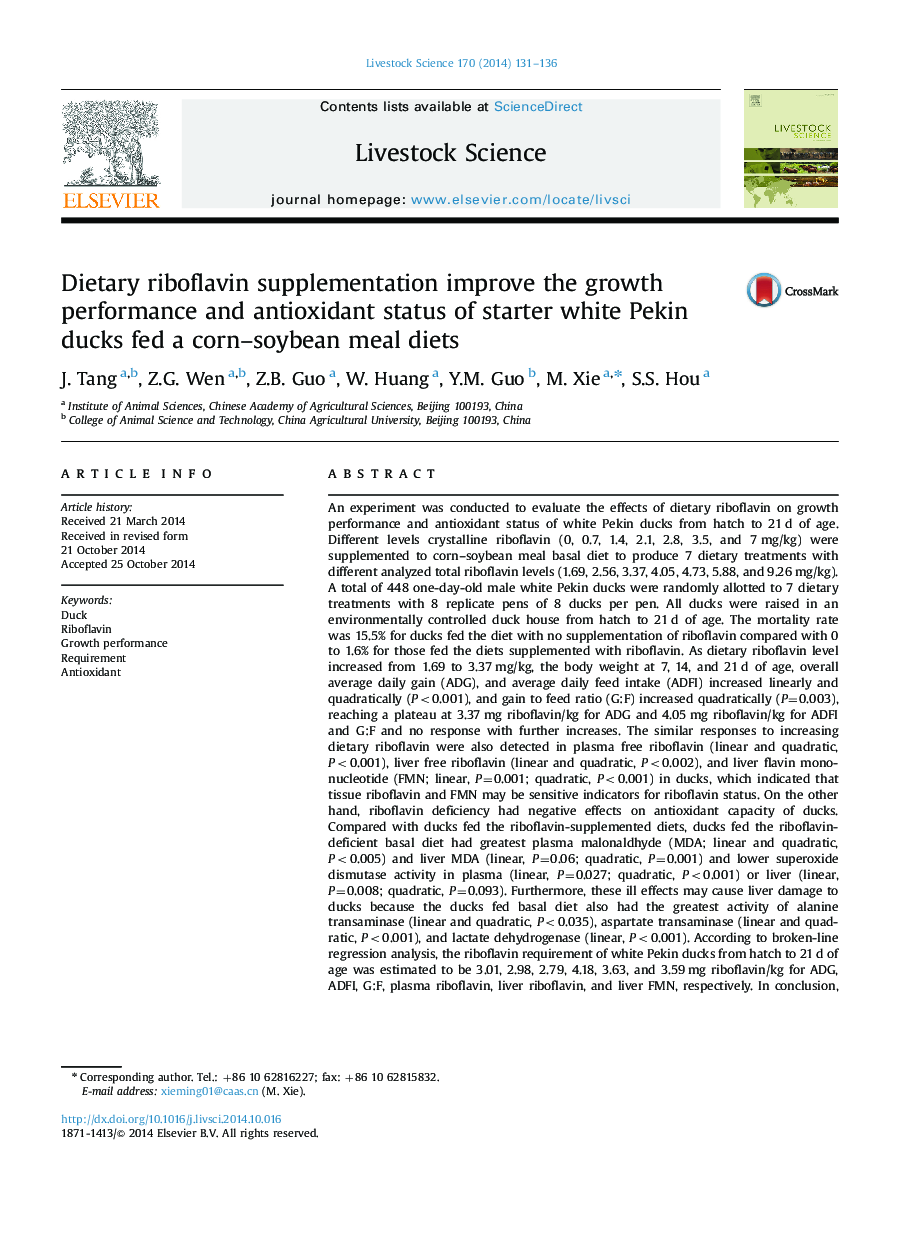| کد مقاله | کد نشریه | سال انتشار | مقاله انگلیسی | نسخه تمام متن |
|---|---|---|---|---|
| 2447174 | 1553962 | 2014 | 6 صفحه PDF | دانلود رایگان |
• A follow-up study basis on corn–soybean meal diets to consolidate the riboflavin requirement of ducks.
• Riboflavin deficiency may cause growth depression, high mortality of ducks.
• Riboflavin deficiency may cause poor riboflavin status and low antioxidant capacity of ducks.
• Riboflavin status of ducks could be indicated by plasma or liver riboflavin.
An experiment was conducted to evaluate the effects of dietary riboflavin on growth performance and antioxidant status of white Pekin ducks from hatch to 21 d of age. Different levels crystalline riboflavin (0, 0.7, 1.4, 2.1, 2.8, 3.5, and 7 mg/kg) were supplemented to corn–soybean meal basal diet to produce 7 dietary treatments with different analyzed total riboflavin levels (1.69, 2.56, 3.37, 4.05, 4.73, 5.88, and 9.26 mg/kg). A total of 448 one-day-old male white Pekin ducks were randomly allotted to 7 dietary treatments with 8 replicate pens of 8 ducks per pen. All ducks were raised in an environmentally controlled duck house from hatch to 21 d of age. The mortality rate was 15.5% for ducks fed the diet with no supplementation of riboflavin compared with 0 to 1.6% for those fed the diets supplemented with riboflavin. As dietary riboflavin level increased from 1.69 to 3.37 mg/kg, the body weight at 7, 14, and 21 d of age, overall average daily gain (ADG), and average daily feed intake (ADFI) increased linearly and quadratically (P<0.001), and gain to feed ratio (G:F) increased quadratically (P=0.003), reaching a plateau at 3.37 mg riboflavin/kg for ADG and 4.05 mg riboflavin/kg for ADFI and G:F and no response with further increases. The similar responses to increasing dietary riboflavin were also detected in plasma free riboflavin (linear and quadratic, P<0.001), liver free riboflavin (linear and quadratic, P<0.002), and liver flavin mononucleotide (FMN; linear, P=0.001; quadratic, P<0.001) in ducks, which indicated that tissue riboflavin and FMN may be sensitive indicators for riboflavin status. On the other hand, riboflavin deficiency had negative effects on antioxidant capacity of ducks. Compared with ducks fed the riboflavin-supplemented diets, ducks fed the riboflavin-deficient basal diet had greatest plasma malonaldhyde (MDA; linear and quadratic, P<0.005) and liver MDA (linear, P=0.06; quadratic, P=0.001) and lower superoxide dismutase activity in plasma (linear, P=0.027; quadratic, P<0.001) or liver (linear, P=0.008; quadratic, P=0.093). Furthermore, these ill effects may cause liver damage to ducks because the ducks fed basal diet also had the greatest activity of alanine transaminase (linear and quadratic, P<0.035), aspartate transaminase (linear and quadratic, P<0.001), and lactate dehydrogenase (linear, P<0.001). According to broken-line regression analysis, the riboflavin requirement of white Pekin ducks from hatch to 21 d of age was estimated to be 3.01, 2.98, 2.79, 4.18, 3.63, and 3.59 mg riboflavin/kg for ADG, ADFI, G:F, plasma riboflavin, liver riboflavin, and liver FMN, respectively. In conclusion, corn–soybean meal-based diet is riboflavin-deficient for ducks and supplementation of riboflavin at such levels in these diets could enhance riboflavin and antioxidant status and growth performance of ducks.
Journal: Livestock Science - Volume 170, December 2014, Pages 131–136
